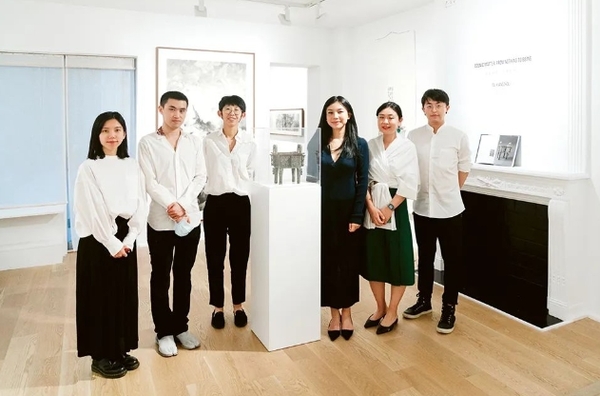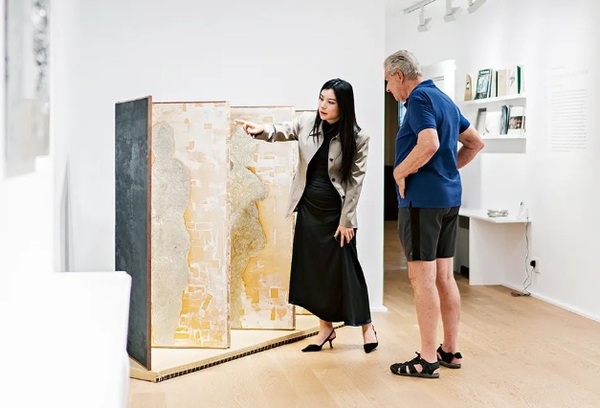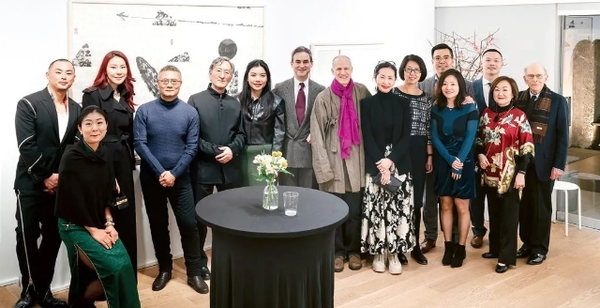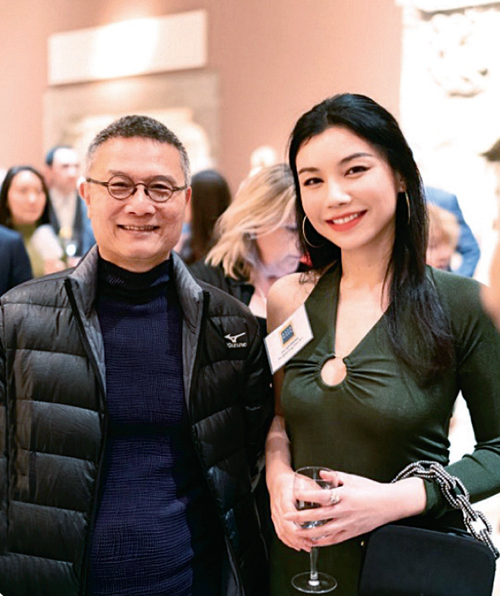Presenting Charm of Cultural Integration to Audiences
 |
| Fu Qiumeng (third from right) and members of her team |
The Chinese ink-and-wash painting is one of the typical forms of traditional Chinese art. In present era of increased intercultural communications, many artists are striving to seek integration of traditional and contemporary art forms. Fu Qiumeng, owner and curator of Fu Qiumeng Fine Art (FQM), in New York, the United States, has made it her mission to promote the Chinese ink-and-wash painting, and to explore ways to fuse classical Chinese culture with contemporary art. Through her innovative approach, the gallery has become a platform for appreciating the beauty of Chinese aesthetics.
Passion
During her undergraduate studies, in the US, Fu pursued a degree in communications. However, growing up engrossed in brushwork, her passion for brushwork led her to take courses in art history, and to delve deep into the study of Chinese art, literature and philosophical history.
In 2012, driven by her passion for the Chinese ink-and-wash painting, Fu made a bold decision: She left her job, related to her university major, and she joined an ancient painting auction house in Beijing. That marked the beginning of her global journey to collect works of art.

During her travels, Fu had a memorable encounter with a collector, from New York, who left a lasting impression on her. "This collector held a deep appreciation for traditional Chinese crafts, like porcelain and bronze, as well as contemporary works that embodied the essence of the ink-and-wash painting. In witnessing her collection, I saw the continuity of China's rich humanistic history. She told me her collection journey was also a search for her cultural identity in a foreign land," Fu says.
The collector's words deeply moved Fu, who had been a Chinese overseas student. "Some Chinese overseas students lacked a comprehensive understanding of traditional Chinese culture. Finding a sense of cultural belonging and identity is what our generation needs," Fu says.
Two years later, Fu enrolled at Northwestern University, in the US, to pursue a master's degree in leadership in creative enterprises. She then worked in an art gallery and an auction house, and she gained insightful knowledge into the status of contemporary and ancient artworks in the New York art market.
Fu discovered that most Chinese ink-and-wash paintings were primarily represented by antique dealers, with auction houses occasionally showcasing contemporary works in traditional styles. However, no galleries were curating or promoting traditional Chinese ink-and-wash paintings. This absence of traditional Chinese art in the New York art field ignited her desire to establish a gallery infused with oriental aesthetics.
In her efforts to bring the ink-and-wash painting into the contemporary context, Fu saw the potential in creating popular art documentaries as a breakthrough. Through these documentaries, she aimed to narrate the process of artistic creation, and to break down the barriers between the audience and the artwork.
In 2016, Fu established FQM, in New York. The gallery hosts exhibitions, lectures, and exchanges, with the purpose of opening a window to traditional Chinese art for audiences.

Deep Exploration
Fu and her classmate, Guo Xinran, launched QM Project in 2018. "At that time, Guo had just graduated from Northwestern University, with a Ph.D. in art history. We were trying to integrate traditional Chinese aesthetic values with global modern and contemporary art, at the academic level," Fu says.
Recognizing there was a lack of academic discourse on works of art based on traditional Chinese aesthetics, Fu and Guo initiated various writing projects, to provide the gallery's subscribers with a deeper understanding of the relationship between Eastern and Western art. In early 2019, Fu faced a challenging task, when Wang Shaofang, head of Wang Fangyu Family Fund, approached her for assistance in organizing his father (Wang Fangyu)'s lifelong manuscripts and research materials.
Wang Fangyu (1913-1997) was a Chinese calligrapher, art collector, and a professor of Chinese at Yale University and Seton Hall University. He established an extraordinary private collection of works by Bada Shanren (1626-1705, whose real name was Zhu Da, an outstanding painting and calligraphy artist in Chinese art history), and then donated the collection to the Freer Gallery of Art, in Washington, DC, which contributed significantly to the study of Bada Shanren.
Aware of the weighty responsibilities bestowed upon her, Fu made the decision to write a research paper, and to curate an exhibition. "I didn't feel confident at first. Wang Shaofang offered his encouragement, and he emphasized that his father conducted research on Bada Shanren out of personal interest. As long as I work with sincerity and diligence, I can always make some achievements," Fu says.
Buoyed by Wang Shaofang's words, Fu had renewed confidence and motivation. She immersed herself in the endeavors of previous generations of literati, who had dedicated themselves to inheriting and promoting traditional Chinese art in the US. She also had a better understanding of how the research into Asian art and history was conducted in American museums and universities.
"Wang Shaofang's guidance has broadened my horizons, and prompted me to contemplate the Eastern and Western art ecosystems from a fresh perspective," Fu says.
After two years of unwavering dedication, Fu curated a groundbreaking literary exhibition, Authentic or Forgery: How Does a Chinese Connoisseur Work? Wang Fangyu's Research on Bada Shanren. This notable exhibition showcased Wang Fangyu's research manuscripts, photographs and documents for the first time. It comprehensively presented the thinking and appraisal methods of Wang Fangyu, and it provided invaluable research and appreciation materials for both general audiences and professionals in the field.

Dialogue and Fusion
FQM represents both Chinese artists, who seek to enhance the voice of oriental art overseas, and Westerners, who are dedicated to studies in traditional Chinese art. Notably, Arnold Chang and Michael Cherney have emerged as prominent figures in these two groups.
"Chang, raised in the US, had studied under the master of Chinese landscape painting, Wang Jiqian (better known in the West as C.C. Wang, 1907-2003). Chang adheres to the foundational principles of brush strokes and ink usage in classical Chinese literati painting to skillfully present the shifting perspectives in his ink-and-wash paintings. Cherney, an American artist who used to study in China, showcases the aesthetic characteristics of traditional Chinese landscape paintings through his photographs," Fu says.
Fu recognized a new possibility for presenting Chinese ink-and-wash painting — fusion of contemporary art and cross media. Together, Chang and Cherney have embarked on a collaborative series of artworks since 2007, and they have blurred the boundaries between traditional Chinese ink-and-wash painting and contemporary photography. This fusion has breathed new life into the presentation of Chinese ink-and-wash painting.

In 2022, FQM hosted an acclaimed art exhibition, Ink Affinities: The Collaborative Works of Arnold Chang and Michael Cherney. That exhibition received wide praise from media in New York. Some of the exhibited works were collected by prestigious institutions, such as the Art Institute of Chicago, the Cleveland Museum of Art, and the Samuel P. Harn Museum of Art at the University of Florida.
Moreover, the gallery has organized exhibitions that integrate traditional Chinese culture with contemporary art. For instance, the gallery hosted a solo exhibition that showcased the works of landscape artist Wang Mansheng. The exhibition was titled Moonlight on Stones. The gallery also curated a group exhibition, which featured the works of new-generation artists, called The Rain Freshens.
Recently, the gallery hosted a solo exhibition by artist Fung Ming Chip. The exhibit, titled Traces of Time, received high praise. "I hope to break down barriers between China and the US, and between traditional and contemporary art, and to present the charm of cultural integration to audiences," Fu says.
After visiting a themed exhibition, The Order of Body, which was co-curated by FQM and artist Chen Duxi, a netizen posted the following comment on a social-media platform: "It is rare to see galleries in New York that focus on the harmonious combination of traditional Chinese art and modern art."
In recognition of her significant contributions to the art community, Fu was invited to join the planning committee for this year's Asia Week New York (March 16-30). "FQM presents a relatively niche art style. We will always stay true to our original aspiration, providing a sense of cultural belonging for overseas Chinese audiences while offering a refreshing artistic experience to American viewers," Fu says.
Photos Supplied by Interviewee
(Source: People's Daily Overseas Edition / Women of China English Monthly November 2023 issue)
Please understand that womenofchina.cn,a non-profit, information-communication website, cannot reach every writer before using articles and images. For copyright issues, please contact us by emailing: website@womenofchina.cn. The articles published and opinions expressed on this website represent the opinions of writers and are not necessarily shared by womenofchina.cn.








.jpg)

 WeChat
WeChat Weibo
Weibo 京公网安备 11010102004314号
京公网安备 11010102004314号